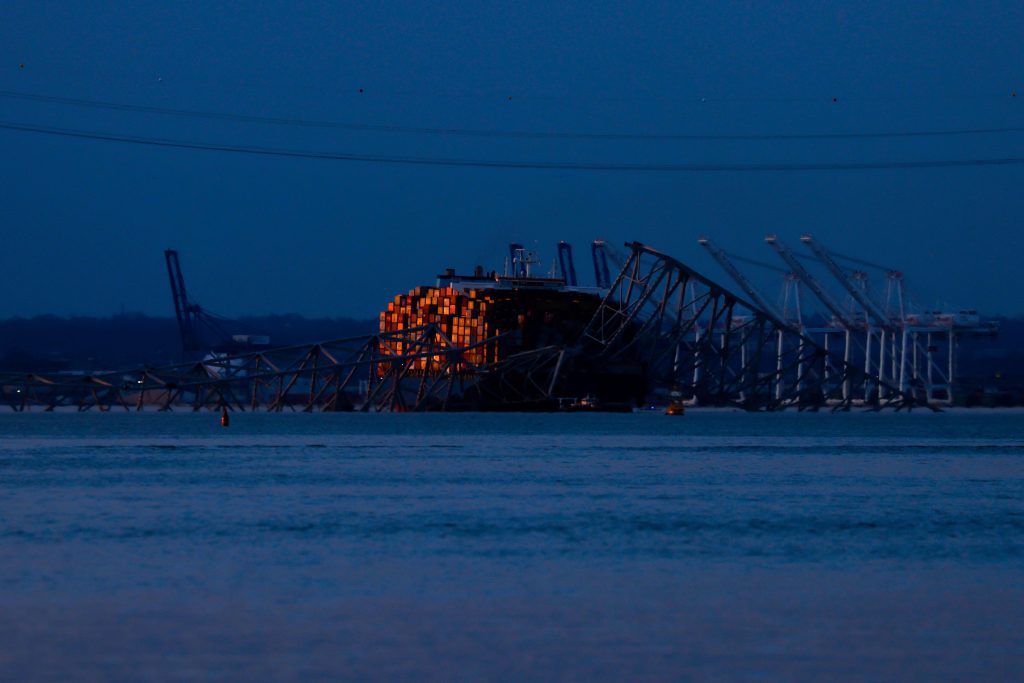By LEA SKENE and TASSANEE VEJPONGSA (Associated Press)
BALTIMORE (AP) — The U.S. Coast Guard has opened a temporary, alternate pathway for ships involved in the removal of wreckage at the location of the collapsed Francis Scott Key Bridge in Baltimore. This is part of a step-by-step approach to opening the main pathway leading to the important port, according to officials.
Teams are working on the complex task of taking away steel and concrete at the place where the bridge tragically fell into the Patapsco River after a container ship lost power and collided with a supporting column. On Sunday, divers inspected sections of the bridge and examined the ship, while workers in elevated platforms used torches to cut parts of the twisted steel superstructure above water.
Authorities have stated that the temporary pathway is accessible only to ships assisting with the clean-up work. It is believed that four workers fell to their deaths in the collapse.
Maryland Governor Wes Moore mentioned during a news briefing on Monday afternoon that his main focus is recovering the four bodies, followed by reopening shipping routes to the port. He acknowledged the urgency but emphasized the significant risks due to the chaotic wreckage of the fallen bridge that crews have described. “We need to work quickly, but we must also be cautious,” he remarked.
“We have to move fast, but we cannot be careless,” he said.
U.S. Coast Guard Rear Admiral Shannon Gilreath stated that divers examining the steel beams below the surface discovered that the steel is tangled and interconnected, posing challenges in determining where they can be cut to make them manageable for lifting out of the water.
“What we’re finding is it is more complicated than we hoped for initially,” Gilreath said.
Moore mentioned that crews used a large crane to cut up and lift a 200-ton (180-metric ton) section of the bridge, which took 10 hours. He described the piece as a “relatively small lift.”
“The magnitude of this project is massive, and even the small lifts are enormous,” he said.
Moore also mentioned that crews will lift another 350-ton (317-metric ton) section from the bridge later on Monday, as weather permits.
Earlier reports stated that the temporary pathway would have a controlling depth of 11 feet (over 3 meters), a horizontal clearance of 264 feet (80 meters), and a vertical clearance of 96 feet (29 meters). A video released on Sunday showed the Coast Guard placing buoys in the water.
“This is an important initial step toward reopening the port of Baltimore,” said Capt. David O’Connell, the federal on-scene coordinator of the response, in a statement on Monday. “By opening this alternate route, we will facilitate the flow of marine traffic into Baltimore.”
President Joe Biden will visit the site Friday, White House press secretary Karine Jean-Pierre announced Monday afternoon. He will meet with state and local officials and get an “on-the-ground look” at federal response efforts, Jean-Pierre said.
Also on Monday, the Small Business Administration opened two centers in the area to assist companies in obtaining loans to help them recover from losses caused by the disruption of the bridge collapse. One of the centers is in Dundalk, a suburb of Baltimore on the northeast end of the bridge.
Yvette Jeffery, a representative for the agency’s disaster recovery office, stated that impacted businesses can get loans for up to $2 million. She noted that the effects could vary from supply-chain difficulties to decreased foot traffic in communities that relied heavily on the bridge.
The bridge collapsed when the crew of the cargo ship Dali lost power and control on March 26. They issued a distress call, which gave police just enough time to prevent vehicles from entering the bridge, but not enough time to rescue a team of eight workers from the structure.
Two workers survived, two bodies were discovered in a submerged pickup, and four more men are presumed dead. Weather conditions and the tangled debris underwater have made it too hazardous for divers to search for their bodies.
The Dali is operated by Synergy Marine Group and owned by Grace Ocean Private Ltd., both based in Singapore. Danish shipping giant Maersk chartered the Dali, which was leaving port when it lost power.
Synergy and Grace Ocean submitted a court petition on Monday to cap their legal liability. This is a standard yet crucial procedure for cases under U.S. maritime law. A federal court in Maryland will ultimately determine culpability and the amount owed.
The filing aims to limit the companies’ liability to around $43.6 million. It estimates the vessel's value at up to $90 million and its cargo worth over $1.1 million in income for the companies. The estimate also factors in two major costs: at least $28 million in repairs and at least $19.5 million in salvage.
Aside from clearing the shipping channel to reopen the port, officials are working to figure out how to reconstruct the major bridge, which was finished in 1977. It served Interstate 695 around southeast Baltimore and became emblematic of the city’s blue-collar roots and maritime culture.
Congress is expected to consider assistance packages to aid those who lose jobs or businesses due to the extended closure of the Port of Baltimore. The port handles more cars and farm equipment than any other U.S. facility.
___
This report includes contributions from Associated Press journalists Mike Pesoli in Baltimore; Jeffrey Collins in Columbia, South Carolina; and Sarah Brumfield in Washington.









